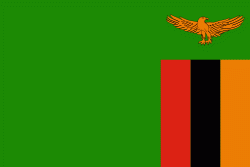Nchelenge District (Nchelenge District)
Nchelenge District is a district of Zambia, located in the Luapula Province. The capital lies at Nchelenge. As of the 2000 Zambian Census, the district had a population of 111,119 people.
Nchelenge is one of the twelve districts of Luapula Province in Zambia, second largest by population size (only next to the provincial capital, Mansa). Other districts being Mansa, Kawambwa, Milenge, Mwense, Chienge, Chembe, Chipili, Chifunabuli, Mwansabombwe, Lunga and Samfya. The district, located north of Luapula province some 250 km away from Mansa is the most densely populated of all the districts in the province at 45 persons per square kilometer. The district has a total surface area of 4.092square kilometers (60% land, 30% water and 10% swamps). The district shares borders with Democratic Republic of the Congo in the west, Chienge District in the north, Kaputa District in the north-east and Kawambwa District in the south-east. Lake Mweru marks the boundary between Nchelenge and Congo DR.
The native inhabitants of Nchelenge are mainly fishers or fishmongers. Due to overfishing, there has been a shift to farming in the past few years to meet people's basic economic needs. The selling of fish and timber, as well as general trading, comprise the main economic activities carried out by people, accounting for some 80 percent of the workforce. The remaining 20 percent are formally employed workers mostly in government departments and various non-governmental organizations in the area. The transport sector in the district has also increased.
Banking services are offered by the National Savings Bank and the Zambia National Commercial Bank; the latter operating as a mobile bank twice weekly from Kawambwa district, located about 90 kilometers from Nchelenge district.
Nchelenge is one of the twelve districts of Luapula Province in Zambia, second largest by population size (only next to the provincial capital, Mansa). Other districts being Mansa, Kawambwa, Milenge, Mwense, Chienge, Chembe, Chipili, Chifunabuli, Mwansabombwe, Lunga and Samfya. The district, located north of Luapula province some 250 km away from Mansa is the most densely populated of all the districts in the province at 45 persons per square kilometer. The district has a total surface area of 4.092square kilometers (60% land, 30% water and 10% swamps). The district shares borders with Democratic Republic of the Congo in the west, Chienge District in the north, Kaputa District in the north-east and Kawambwa District in the south-east. Lake Mweru marks the boundary between Nchelenge and Congo DR.
The native inhabitants of Nchelenge are mainly fishers or fishmongers. Due to overfishing, there has been a shift to farming in the past few years to meet people's basic economic needs. The selling of fish and timber, as well as general trading, comprise the main economic activities carried out by people, accounting for some 80 percent of the workforce. The remaining 20 percent are formally employed workers mostly in government departments and various non-governmental organizations in the area. The transport sector in the district has also increased.
Banking services are offered by the National Savings Bank and the Zambia National Commercial Bank; the latter operating as a mobile bank twice weekly from Kawambwa district, located about 90 kilometers from Nchelenge district.
Map - Nchelenge District (Nchelenge District)
Map
Country - Zambia
 |
 |
| Flag of Zambia | |
The region was affected by the Bantu expansion of the 13th century. Following the arrival of European explorers in the 18th century, the British colonised the region into the British protectorates of Barotseland-North-Western Rhodesia and North-Eastern Rhodesia comprising 73 tribes, towards the end of the 19th century. These were merged in 1911 to form Northern Rhodesia. For most of the colonial period, Zambia was governed by an administration appointed from London with the advice of the British South Africa Company. On 24 October 1964, Zambia became independent of the United Kingdom and prime minister Kenneth Kaunda became the inaugural president. From 1972 to 1991 Zambia was a one-party state with the United National Independence Party as the sole legal political party under the motto "One Zambia, One Nation" coined by Kaunda. Kaunda was succeeded by Frederick Chiluba of the social-democratic Movement for Multi-Party Democracy in 1991, beginning a period of government decentralisation.
Currency / Language
| ISO | Currency | Symbol | Significant figures |
|---|---|---|---|
| ZMW | Zambian kwacha | ZK | 2 |
| ISO | Language |
|---|---|
| NY | Chichewa language |
| EN | English language |















